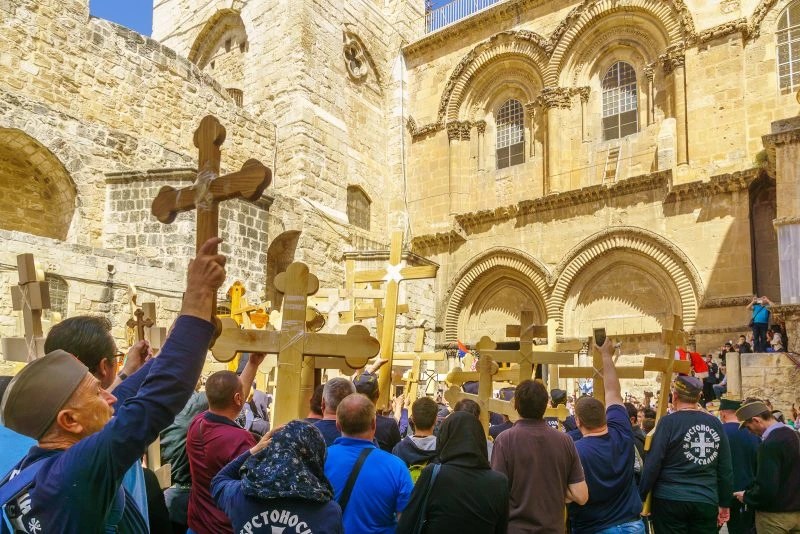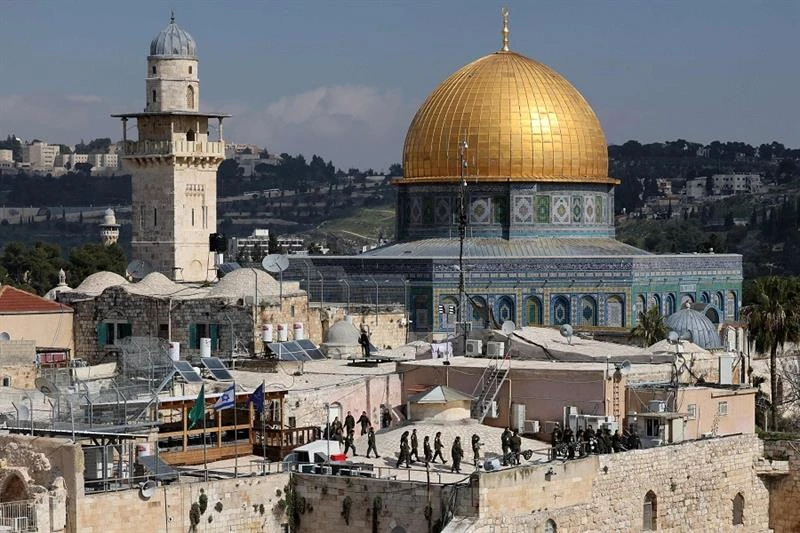The Nativity Church, located in Bethlehem, counts among the all-holiness points and historically recognized points in all Christianity worldwide. Above all, it is honored and revered as Jesus Christ's birthplace. Thus, it naturally draws millions of pilgrims and other guests yearly. This ancient church actually stands in the heart of Bethlehem for over 1,600 years, with UNESCO Heritage Site status. It was originally built by Emperor Constantine in the 4th century and renovated and expanded in various periods, reflecting the ever-changing spiritual and architectural evolution in the region. The most cherished part of the church is the Grotto of the Nativity, a small cave below the altar marking the traditionally accepted birthplace of Jesus. Thus, with that history, religiously deep roots, and stunning architecture, it is a very important destination for searching through the historical roots of Christianity in Holy Land packaegs.
The History Behind the Church of the Nativity: A Journey Through Time
The Early Origins
It is believed that the Church of the Nativity is built at the actual spot where Jesus came to be born, according to the Gospel of Matthew and the Gospel of Luke. By the second century onward, early Christian pilgrims had begun identifying Bethlehem as the birthplace of Jesus, taking efforts to mark it. In AD 327, the Roman Emperor Constantine and his mother Helena ordered the construction of a church at the site. The church was said to have been built over the cave where Jesus was supposed to be born."Originally, it was very small and modest, but it set the actual footing for an eventual site famous for its religious significance.
The Construction of the 4th Century Church
One of the significant contributions made by Empress Helena in the early establishment of Christian holy places was the Church of the Nativity. This church, completed in 339 A.D., comprised a basilica and a group of chapels arranged around the cave itself. Its architecture flowed in Roman style, with a grand entrance and spacious interior forming the place of Christian worship and pilgrimage.
Destruction and reconstruction
The Church of the Nativity experienced ruin in the hands of invasions and a different catastrophic event through the ages. Thus, in the sixth century, during the reign of Byzantine Emperor Justinian I, this church was renovated and expanded by the insertion of mosaic decorations and other architectural elements.
The 20th Century and Modern-Day Preservation
There have been many conservation actions taken on this church of the Nativity in the last century. It was handed over to the Palestinian Authority following the signing of the Oslo Accords, as for Bethlehem and for its religious sites, including the Church of the Nativity, during the 1990s. From then, efforts were undertaken to protect and preserve the church, with the major renovation project taking place in the 2010s under the funding of the Palestinian Authority and international organizations.
In 2012, UNESCO designated the church a World Heritage Site, further making provision for its protection and recognizing it as one of the most revered Christian monuments globally.
Architectural Wonders of the Church of the Nativity
Basilica Form: Interior Front
The Church of the Nativity was developed as a basilica-style structure, a common basilica style in early Christian architecture. It has a centre nave, parallel aisles, and an apse ending in a semicircle at the eastern end. The main entrance is made very low, or the "Door of Humility," constructed to deny entry to intruders and encourage humility within those personally entering by bowing their heads as they go through the small, low, narrow door.
The Grotto of Nativity: The Heart of the Church
The heart of the church is the Grotto of the Nativity, right beneath the altar. According to tradition, it was the birthplace of the Jesus Christ. It consists of a small cave-like structure and marks, on the floor, the site where he is said to have been born by means of a silver star. This place is illumined with candles and surrounded by exquisite marble decorations. Many pilgrims and visitors gather around this star to contemplate and pray, but also to enjoy the deep religious atmosphere of the place.
Byzantine Mosaics and Decorations
The Church of the Nativity's most striking architectural features is their ancient-style decoration in Byzantine mosaics. These mosaics date back to the sixth century and adorn the ceilings and walls of the church, which, like some other magnificent wonders, cause one to exhale in wonder and amazement. Here, elaborate images of saints, angels, and biblical scenes embellish the whole atmosphere of the church. Many of these have undergone restoration yet still have the magic and history inherent in them.
The Crusader Influence: Strength and Fortification
Under the rule of the Crusaders, the church underwent radical transformations in the 12th century. The building had been heavily fortified by the Crusaders to allow the church to defend itself successfully as an important site during the Crusades. The thick stone walls and arched windows gave a more fortified appearance to the structure. In this period, the main entrance was further lowered, thus making it even smaller, as if it had been meant for a defense to prevent cavalry from entering.
The Iconostasis: The Abode of the Divine
Another significant aspect of the church is the iconostasis, a wooden screen hung with religious icons separating the sanctuary from the church's main part. The iconostasis features dominant in Eastern Orthodox Christianity serve as a symbolic barrier from the sacred space of the altar to the congregation. Icons representing the main persons in Christian theology, such as Christ, the Virgin Mary, and different saints, are painted on the screen.
Beautiful columns and ceilings:
Inside the church, visitors can see how beautiful the columns are supporting the church structure, such as the columns made from different kinds of materials such as marble, limestone, and sandstone, which illustrate that this site has undergone changes of styles and influences in architecture over centuries. Along with an equally beautiful ceiling of wooden beams applied to beautiful patterns are signs of handcraft from the Crusader and Byzantine periods.
Present-day renovations and Preservation Actions
Through the centuries, the Church of the Nativity has been undergoing numerous renovations and preservation efforts to keep alive its historical and religious importance. During the 2010s, considerable restoration works were performed to conserve the church's mosaics, flooring in marble, and structural integrity of the church building. In 2012, it became a UNESCO World Heritage site, gaining full steam towards international attention for its preservation as an important structure. This and other such efforts would see to it that these architectural works continue to inspire future generations in pursuit of better things.
Architecture of Cultural and Religious Coalescence
What is most amazing about the architecture of the Church of the Nativity is that it holds influences and mixtures of cultures at different points in time. It starts from the earliest beginnings within the Christian basilica and Byzantine mosaics to Crusader fortifications and modern restorations—the church is an amalgamation of periods, all of which contribute to its spiritual architectural being. Their blended styles are reflective of that extremely rich and varied heritage—the heritage of the Holy Land itself, where all these cultures, religions, and histories have interlined over centuries.
Planning Your Visit to the Church of the Nativity: Tips for Pilgrims and Tourists
1. Perfect Timing for a Visit
The Church of Nativity is one famous site for pilgrims and tourists' visits. The importance of your visit time in this destination is incredibly great. Christmas is the peak time to visit this site. The twenty-fourth and the twenty-fifth of December draw thousands of pilgrims arriving at Bethlehem to honor the birth of Jesus. You might want to visit when the site is not as crowded, which usually runs between March and May or September to November-to relish a more privy experience.
2. Dress Modestly and Respectfully.
As every other holy site, anyone who visits the site of Church of the Nativity is expected to come by with the proper attire; otherwise, their visits may not be given so much respect because of its holiness. Both genders will have to be covered shoulder down to the knees. It would be comfortable to have on also shoes since indicating some walking and standing would be required with these cobblestone floors and uneven surfaces in that church. Expect more church rules and guidelines on entrance into such parts as the Grotto of the Nativity.
3. Understand the Importance of the Place
It is good to know before visiting the Church of the Nativity the historical and religious significance that it holds. This church is believed to be the traditional birthplace of Jesus Christ, and it is also a UNESCO World Heritage site. The church was erected by Emperor Constantine and Empress Helena in the 4th century. Nestled under the altar is the Grotto of the Nativity, the focal point of the church and believed to be the actual place where Jesus was born. Knowing this, and visiting with that in mind will add meaning to your journey and allow you to appreciate the spiritual importance of the church.
4. Be Ready for Security Checks:
Bethlehem is situated in the heart of the West Bank, where visitors would need to pass through checkpoints when travelling in from or around Jerusalem. Such security checks are the norm and will most likely take a little time but are necessary for safety and security. Have your passport or identification with you, as some tourists may be required to prove their nationality. It is also good to check for the current political scenario or travel advisories prior to travelling so that your trip goes smoothly.
5. Arriving Early to Avoid Crowds
The Church of the Nativity tends to get crowded during the pilgrimage seasons. It would be best, therefore, to go first thing in the morning when it is less crowded in order to avoid the rush. You can then comfortably see the Grotto of the Nativity and the other important sites without feeling rushed or crushed in by crowds. The silence of the morning surrounding this makes the experience even more spiritual and allows for solitary reflection and prayer.
6. Participate in Religious Activities
For pilgrims, attending a service or mass lit within the Church of the Nativity tends to form an integral part of the visiting experience. However, apart from the general regular Christian services, it provides a plethora of special occasions such as Christmas and Easter, wherein the faithful get an opportunity to attend mass in this holy site, and together feel the sacred history of the place while experiencing a vibrant community of religion in the church.
7. Observe Local Customs and Traditions
Bethlehem is a city rich in traditions and customs, a predominantly Palestinian Christian city. It is important to respect the people around you, especially when visiting holy spaces. No loud chats or disruptive behavior are permitted. Also, if you happen to be here during religious holidays or festivals, respect the special events or services in the church.
8. Respect Photography Guidelines
There are some parts of the Church of the Nativity that allow photography, but it forbids or restricts the taking of pictures out of respect for the sanctity of a place like the Grotto of the Nativity. Always listen to signs or instructions from the church staff when it comes to taking pictures. Be aware while taking pictures of other visitors: some may be seeking a quiet and reflective space.
The Church of the Nativity, It is the birthplace of Jesus Christ. It is a very meaningful space for millions of Christians around the world. Its architectural beauty and historical value make it obligatory for anyone interested in the Holy Land to visit. If you are a regular visitor hoping to witness the ancient history of Bethlehem, this church surely moves and offers profound enlightenment. A day tour of the Holy Land may be an enriching opportunity to visit this particular sacred site and other major sites in Bethlehem and Jerusalem, increasing one's scope of understanding about the spiritual heritage that best defines the area. It has left an inspirational legacy, and today it continues to inspire reverence and reflection, thereby being that place where past and present beautifully converge for their celebration in life, faith, and hope.







-webp.webp)


